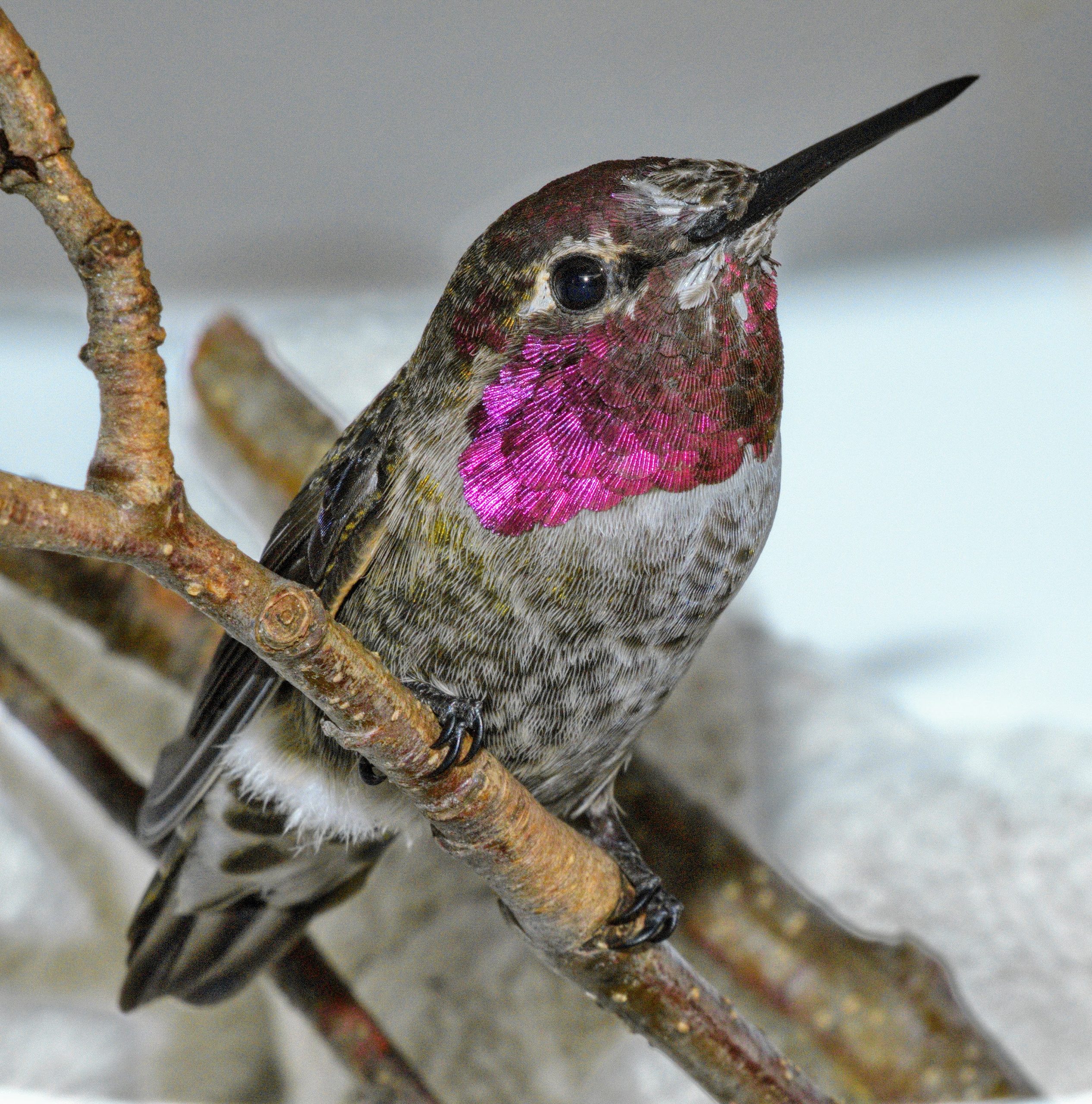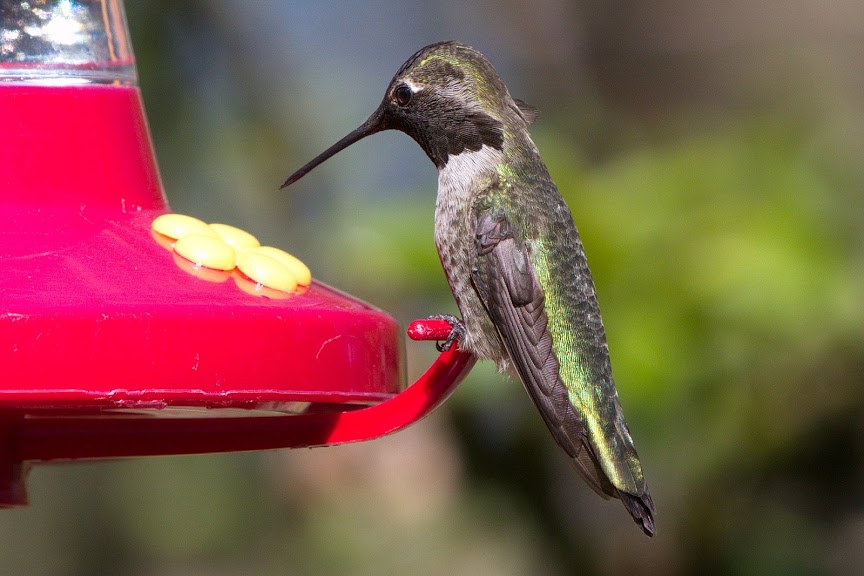Support Us
Since 1979 more than 140,000 animals have been treated by Wildlife Rescue.
Thanks to the support of individuals like you, Wildlife Rescue can provide a lifeline for animals in distress.
The Ultimate Quick Guide to Hummingbird Feeders
Hummingbird feeders are a delightful addition to any backyard. If you set one up in the Lower Mainland, you can watch our native Rufous Hummingbirds and Anna’s Hummingbirds flit and feed.
Ideally, all hummingbird feeders should be taken down in September of each year before migration begins. Leaving feeders up will not discourage migration, as hummingbirds that migrate are instinctually driven to do so, however; it can alter their feeding behaviors. In some cases, these feeders are left up unknowingly and without proper care, which can ultimately lead to the fungal infections, starvation and death of the hummingbirds which have become dependent on them for survival.

Hummingbird’s diet is critical for their survival. Hummingbirds can consume half their weight in pure sugar every day. Nectar fuels hummingbird’s metabolism – the highest of an endothermic animal on the earth. Although these food sources are readily available in the spring and summer, winter becomes challenging. Insects and nectar-bearing flowering plants are scarce during freezing temperatures.
The hummingbirds who are unable to find food come to Wildlife Rescue in critical condition – thin and in distress because of reduced food intake due to frozen feeders, less flowering native plants and insect populations in the winter. Some of these birds show signs of infection caused by dirty feeders that can result in fungal and bacterial infections in their GI tract or respiratory system. Tragically, these birds usually die or suffer through severe respiratory distress.
When set up properly, hummingbird feeders can have a positive impact on hummingbird populations. This post will answer some common hummingbird feeder questions and teach you best practices when feeding hummingbirds.
Why do Hummingbirds Stay in the Winter?
What is the best food for hummingbirds?
A simple mixture of refined, white table sugar dissolved in hot water is sufficient. The standard mixture is ¼ cup sugar to 1 cup water.
Make sure the mixture cools to room temperature before you “serve” it to your avian clients. If you have refrigerated a large batch of sugar water, allow warming to room temperature before serving.
Avoid staining the sugar water with red food colouring. Hummingbirds are attracted by the red colours of the feeder itself, not the nectar inside.

How do I keep hummingbird feeders safe and clean for birds?
Since sugar can ferment, it is important to replace hummingbird feeders once every day or every other day and give the feeder a thorough clean. In the summer, clean feeders every day if temperatures exceed 32 degrees or higher and every 2-3 days in cooler temperatures. Never let a feeder sit out for more than three days.
The best size hummingbird feeder for you is one that naturally empties every day or two. Because hummingbirds are territorial, it is also better to have several small feeders than one large feeder that may not empty in time. If you are unable to practice cleaning and hygiene for your feeder it might be a good idea to plant native flowers that attract hummingbirds instead.
Leaving feeders up during the winter can make them freeze, it might be a good idea to have two hummingbird feeders to ensure you can leave a fresh one out in the morning and remove the frozen when during the day. Learn more about navigating your hummingbird feeder during the cold snaps here.
Do hummingbird feeders affect migration?
Leaving feeders up will not discourage migration, as hummingbirds that migrate are instinctually driven to do so, however; it can alter their behaviors.
Putting up feeders in the late fall will allow birds to store up energy for their long annual migrations. And keeping feeders around during the winter can help stragglers catch up to their bird-friends further south. However, the U.S. Fish and Wildlife Service recommends taking down winter feeders if the feeders attract hummingbird species not native to the area.
How can I keep ants and other pests away from my feeder?
Choosing a well-built feeder is the best way to avoid pests. Saucer designs and feeders with built-in moats do a good job of keeping away unwanted bugs like bees and ants. Avoid yellow bee guards because the yellow might attract bees.
If the perches are large enough, you may get other birds like orioles and Downy Woodpeckers. If you live in an area with bears, that may also be a problem, so be careful if you live in bear country.
How to help wildlife in distress?
As a wildlife rehabilitation centre we provide care to a lot of birds that have illnesses using bird feeders. When birds fall ill, they need to find easy food sources to stay alive, because they lack energy and ability to scavenge food on their own they flock to other bird feeders. This cross-contamination creates fungal and bacterial infections that are contagious and can spread quickly. In a flock situation, the birds will naturally fall behind and not contaminate the other birds. However, if a feeder is present the bird will leave behind bacteria or fungus that can then transfer to the other animals allowing them to spread it. Which in turn allows unhealthy birds to catch the illness. If you see a diseased bird or animal at your feeder, we recommend capturing the bird safely and bringing it to your local wildlife rehabilitation centre, then remove the feeder for at least a week to disperse the population and clean it thoroughly. Good hygiene of the feeder can prevent these issues from occurring.
With winter around the corner and suspected drop in temperatures you may come across hummingbirds and other wildlife in distress. Please contact our Support Centre for assistance. Some signs to watch for are birds on the ground, soiled, confused, visible injuries and unable to fly. For more information on what to do when you find an animal click here.
Save your local Hummingbirds today!